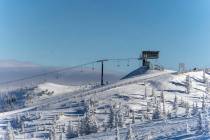Trust expert for tips on making your gardens grow
Gardening talk-show host Don Davis has moved his 20-year-old program up the radio dial to KDOX-AM, 1280. Many of his old listeners lost him in the transfer from KDWN-AM, 720 and he wants to let them know where he is.
You can listen as well as call him for answers to your gardening questions during his show from 9 to 11 a.m. every Saturday. His advice comes from years of gardening, nursery work, designing and teaching courses at the University of Nevada, Las Vegas. He knows how to garden in this hostile desert.
Since most of us work in our gardens on Saturdays, and with cell phones at our fingertips, it is convenient to call him when you find a problem. He can better answer your question when you are standing in the garden describing it. His phone number is 395-1280.
The original garden show lasted an hour, but has expanded to two hours. As Davis develops his audience, he plans to expand to a three-hour show. Davis also hopes to link his show up with other Southwest radio stations to spread his gardening word.
He is developing his own Web site -- www.outwestgardening.com -- and wants to set it up so those going out of town will be able to listen from anywhere in the world. The longtime garden expert is attempting to set up links that you will be able to use to retrieve a show. With Davis' desire and drive, he wants to become the gardening guru of the Southwest.
Davis lives in the upper Moapa Valley near Hidden Valley, where the Muddy River meanders through his property and many beautiful horses graze in the pasture. He now has equipment that enables him to do the show from home. With this in mind, you never know what he is doing while answering your questions: currying his horses or riding them or even on those mountain slopes of Colorado where he spends his vacations.
He always has his camera ready to take those unusual pictures of breathtaking scenes of those mountains. I have sat through many interesting lectures only to have a slide of those mountain slopes in full color suddenly appear. While letting you enjoy the scene, he is sipping on a Pepsi.
Davis has his own landscape and design company, Don Davis and Associates. He does lots of consulting, which often comes from his listeners. He also does a lot of landscape designing and installations throughout the valley.
When listening to Davis, it is as if you are talking over your fence with him in your yard. He takes more time than I do with callers, and finds other listeners may have the same question or something similar. He'll give the listener three or four ideas to work from.
For example, a man called in to complain about a Texas umbrella shade tree between him and a neighbor. The man wanted to get rid of it while the neighbor wanted to keep it. Their homes are 14 feet apart. The tree has the potential of getting 30 feet tall and as wide. It also is very messy when pods drop, and limbs easily break off during gusts of wind. Neither wanted to clean up the debris, and in true Davis fashion, he gave him six ways to solve the problem:
1. Live with it or remove it.
2. Replace it with a smaller tree such as a shoestring acacia or desert willow.
3. Provide a root barrier between the tree and homes and sidewalks so roots won't break them up.
4. Replace sidewalks with steppingstones or interlock steps that move with the roots.
5. Continue to vigorously prune often.
6. Or forget about it and watch more television.
Another question he encounters is planting the right plant in the right place.
For example, a person wanted a plant that matured just below his front bay window, which is about 3 feet high. But his gardener put in a bush that grew more than 8 feet tall and he had to continually prune it. Davis recommended that he remove it and plant Tecoma stans Gold Star, which grows 3 feet high. Here is the beauty of this plant: It stays low and covers itself with gorgeous golden blooms all through the summer.
Another listener wanted evergreen shrubs that didn't need any pruning, didn't drop leaves or need fertilizer and are water efficient.
"About the only bush I could recommend was plastic plants," he said with a grin.
Another person wanted me to recommend some shrubs and flowers that will grow beneath a tree. He kindly let the listener know there are hundreds of plants that come to mind that fit that scenario. It becomes difficult to paint a picture that the caller can see.
Davis often compares this kind of question to a woman selecting clothes for a special occasion. The first decision is picking out the dress. The second is picking out the shoes, and if she has lots of them that may complicate the issue. Third, she must select a necklace, then earrings and finally a purse. Can you see how complicated it becomes when you have so many plants to choose from, while keeping our harsh climatic conditions in mind?
Davis says the first and last plants are the easiest to select.
1. First, pick a focal point plant such as a palo verde tree.
2. The next layer of plants must complement your first choice and every choice thereafter in size, shape, texture, structure, pruning requirements, shade tolerance and water efficiency. There are a large number of plants to select from, but you finally zero in on a few.
3. Your last choice will be easy, as you probably will have only one or two to choose from.
"Each decision affects the last and next decision. But if done right, your landscape will never look crowded and you won't be pruning very often. And note this, you will eliminate the hedge shears and weed trimmer. Sun exposure won't be a problem. When you put the right plant in the right place, you can dance with the garden for years to come," Davis said.
Recalling my experience when it comes to selecting plants, people come to the Desert Demonstration Gardens wanting a recommendation for one tree. I used to advise them to come to the gardens and observe the 30 mature trees so they can select the one they like.
Linn Mills writes a garden column each Thursday. You can reach him at lmills@reviewjournal.com or at the Gardens at the Springs Preserve, 822-8325.
LINN MILLSMORE COLUMNS























